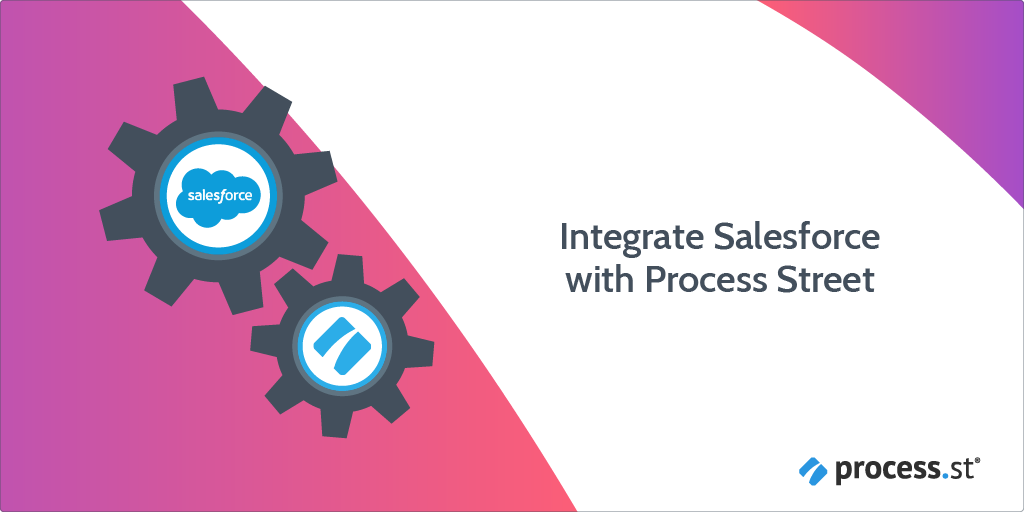
You can integrate Process Street with Salesforce, using Process Street’s Automations.
This integration allows you to perform a number of different automations, such as running a workflow in Process Street when a record is updated in Salesforce, or updating a record in Salesforce when a task or a workflow run is complete in Process Street.
Salesforce: Ensure you have a Salesforce plan with API access (Enterprise, Unlimited, Developer or Performance Edition). You might also consider setting up an Integration user or service account in Salesforce specifically for integrations. Contact your rep if you need support.
Users: In order to create or update Automations, you must be an Administrator or a Full Member with “edit” permissions.
Before you get started you’ll need to have a few things set up in your Process Street workflow.
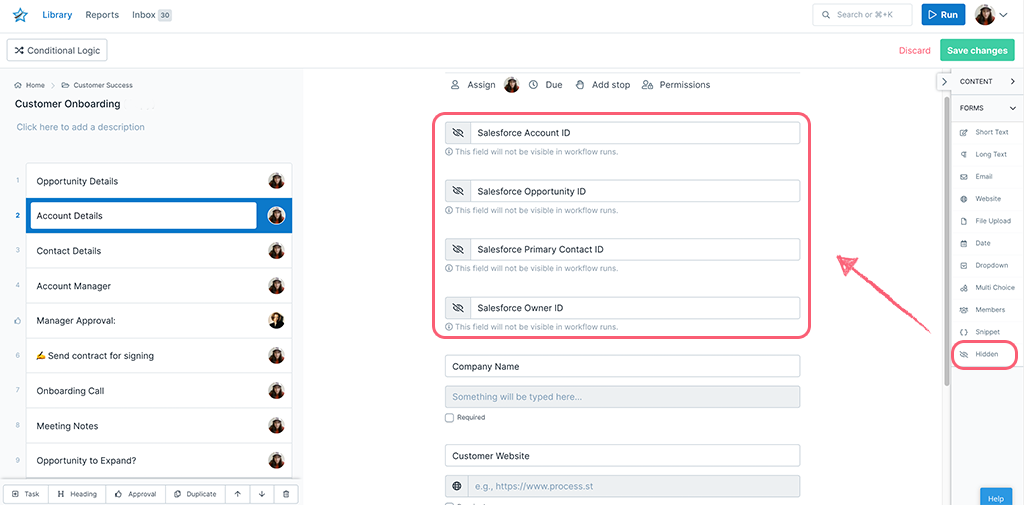
Now you’re ready to go ahead and start creating your automation!
Head to your Library and open up the workflow you’d like to create an automation for. When viewing the workflow you will see the “Automations” tab next to the workflow tab, as shown below.

Start by selecting the trigger for your automation, from the left side of your screen.
For Salesforce automations, you can choose from these three triggers:
Click the + button on your chosen trigger to get started.
Let’s walk through examples for each of these triggers and their respective actions.
Select “Run a workflow when…” from the left side of your screen.
Click the Salesforce icon and a small tick will appear to confirm your selection.
Choose between the two actions (or use them both separately, it’s up to you!)

In this example, when the “Opportunity type” field is updated in a record in Salesforce, a new customer onboarding workflow run is created in Process Street, with data mapped across from the record into your run.

When you select your chosen action, a pop-up window will appear and you will be prompted to choose a Salesforce account to run your automation through.
If it’s the first time you are connecting to Salesforce via Process Street, a pop-up window will appear for you to be able to create a new authentication.
Note: You will need to disable pop-ups blockers to allow you to authorize an app.
If you already have an account connected, then you can continue with the one shown, or select another account to add.

Required: Choose your record type (e.g. Opportunity) and the field you’d like to watch (e.g. Opportunity Type).
Optional: Choose a field value to match. Here you can specify the exact opportunity type (or if you’re using accounts, the exact opportunity type e.g Closed Won) to act as your trigger.
Optional: Check the box underneath to “Include created records” when new records of this type are added.

Give your workflow run a name. You can choose one field here which will be pulled from Salesforce e.g. Opportunity Name.
If you don’t select a name then your workflow run will be called “Auto created from record type” by default. E.g. “Auto created from opportunity“.
Click “Next”.
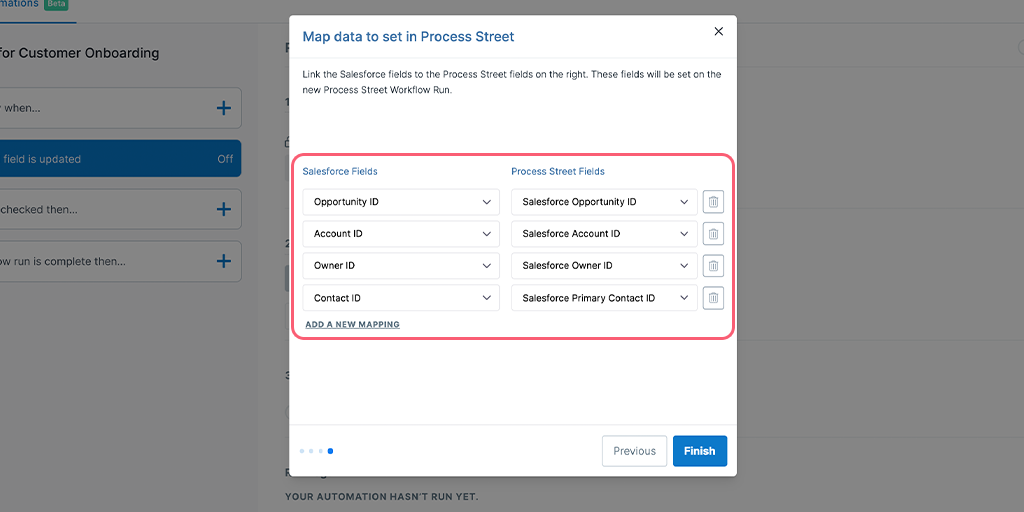
Next, you need to map the fields from Salesforce, that you would like to fill out automatically inside form fields in your new workflow run.
These could be Opportunity ID, Account ID, Owner ID, Contact ID, etc.
Click “Add new mapping” to map more fields. When you’re done mapping, click “Finish”.
Now you’re ready to turn on your automation. Use one of the toggle switches shown below, to switch it on.
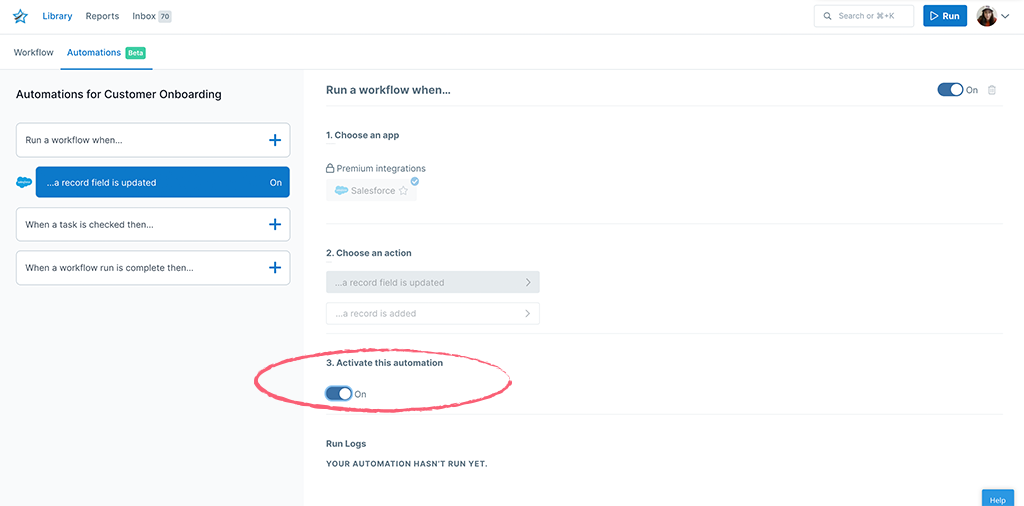
Now every time your record is updated in Salesforce, a workflow run will be created in Process Street with data mapped between the two.
In this example, when you add a new contact in Salesforce, a new customer onboarding workflow run is created in Process Street, with data mapped across from Salesforce into the run.
Select “Run a workflow when” from the left side of your screen.
Next, click the Salesforce icon and a small tick will appear to confirm your selection.
Select the action “a record is added”

When you select your chosen action, a pop-up window will appear and you will be prompted to choose a Salesforce account to run your automation through.
If it’s the first time you are connecting to Salesforce via Process Street, a pop-up window will appear for you to be able to create a new authentication.
Note: You will need to disable pop-ups blockers to allow you to authorize an app.
If you already have an account connected, then you can continue with the one shown, or select another account to add.
Choose your record type (e.g. Contact)

Optional: Give your workflow run a name. You can choose one field here e.g.“Full Name” or “Title”. If you don’t select a name then your workflow run will be called e.g. “Auto created from Contact” by default.
Click “Next”.

Now you need to map the fields from Salesforce, that you would like to fill out automatically inside form fields in your workflow run.
These could be “First name”, “Last name”, “Account ID”, “Email” etc.
Click “Add new mapping” to map more fields. When you’re done mapping, click “Finish”.
Now you’re ready to turn on your automation. Use one of the toggle switches shown below, to switch it on.

Now every time you add a record of a certain type in Salesforce, a workflow run will be created in Process Street with your chosen data mapped between the two apps.
Select “When a task is checked” from the left side of your screen.
Start by selecting the task in your workflow that will act as your trigger.
Next, click the Salesforce icon and a small tick will appear to confirm your selection.
Choose one of the following actions, an example for each one follows below:

In this example, when you complete a task in your workflow run, data is pulled through from a Salesforce record into your run.
Select “When a task is checked” from the left side of your screen.
Next, click the Salesforce icon and a small tick will appear to confirm your selection.
Select the action “find record by ID & update workflow run”
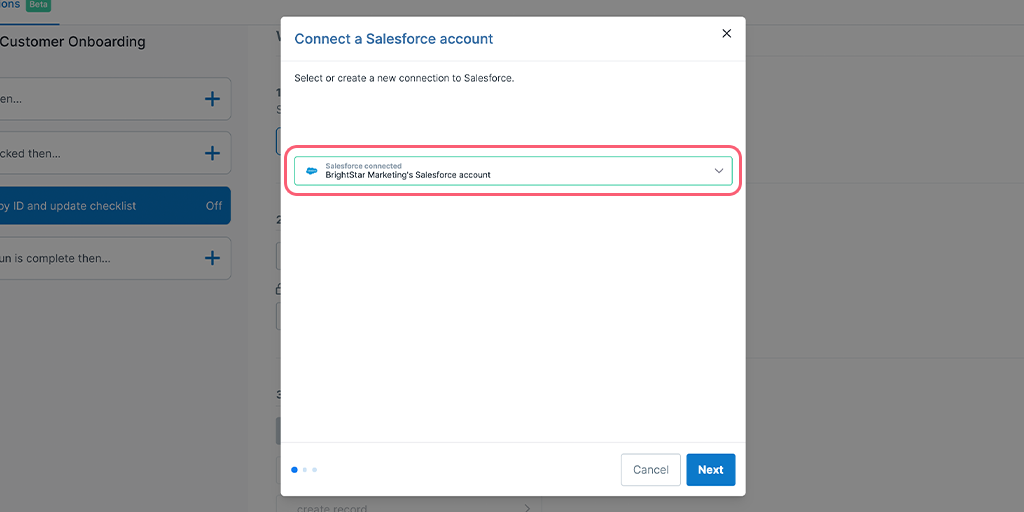
When you select your chosen action, a pop-up window will appear and you will be prompted to choose a Salesforce account to run your automation through.
If it’s the first time you are connecting to Salesforce via Process Street, a pop-up window will appear for you to be able to create a new authentication.
Note: You will need to disable pop-ups blockers to allow you to authorize an app.
If you already have an account connected, then you can continue with the one shown, or select another account to add.

Choose your record type (e.g. Account) and the field you’d like to use in Process Street (eg. Account ID)

Next, you need to map the fields in Salesforce that you would like to update in your workflow run in Process Street.
Click “Add new mapping” to map more fields. When you’re done mapping, click “Finish”.
Now you’re ready to turn on your automation. Use one of the toggle switches shown below, to switch it on.

Run the workflow and when you check off your chosen task, data will be mapped into your form fields.
In this example, when you’ve completed a task in your client onboarding workflow run, the opportunity record in Salesforce is updated with details from your run.
Start by selecting the task in your workflow that will act as your trigger.
Next, click the Salesforce icon and a small tick will appear to confirm your selection.
Choose “update record”

When you select your chosen action, a pop-up window will appear and you will be prompted to choose a Salesforce account to run your automation through.
If it’s the first time you are connecting to Salesforce via Process Street, a pop-up window will appear for you to be able to create a new authentication.
Note: You will need to disable pop-ups blockers to allow you to authorize an app.
If you already have an account connected, then you can continue with the one shown, or select another account to add.

Choose your record type (e.g. Opportunity) and the field you’d like to use in Process Street to map the ID against (e.g. Opportunity ID).
Next, you need to map the fields in Salesforce that you would like to update in your workflow run in Process Street. E.g. notes from your run and “description” in your opportunity in Salesforce.

Click “Add new mapping” to map more fields. When you’re done mapping, click “Finish”.
Now you’re ready to turn on your automation. Use one of the toggle switches shown below, to switch it on.
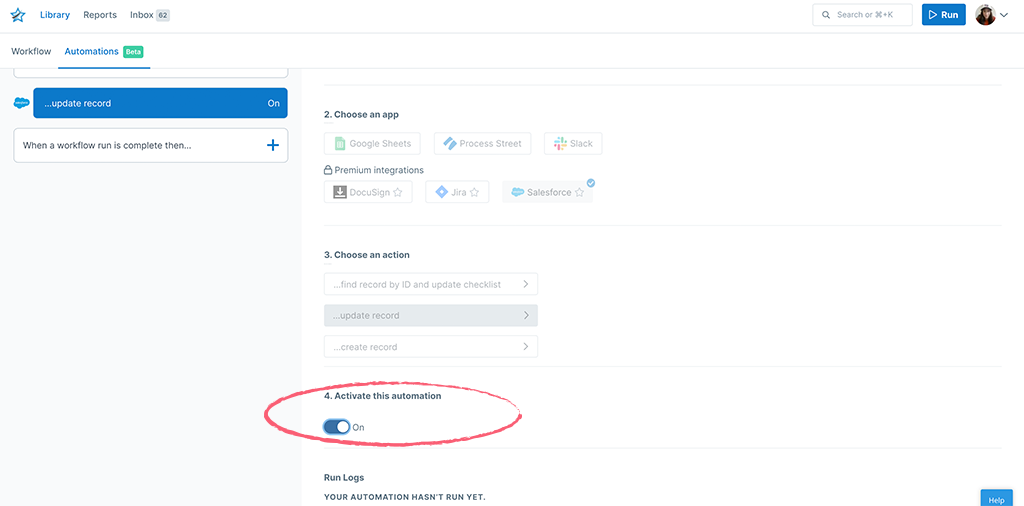
Now every time you check off that task, you update your record in Salesforce, with the data mapped across from Process Street.
In this example, when you check off a task in your support workflow run, a new case is created in your service dashboard in Salesforce.
Start by selecting the task in your workflow that will act as your trigger.
Next, click the Salesforce icon and a small tick will appear to confirm your selection.
Choose “create record”

When you select your chosen action, a pop-up window will appear and you will be prompted to choose a Salesforce account to run your automation through.
If it’s the first time you are connecting to Salesforce via Process Street, a pop-up window will appear for you to be able to create a new authentication.
Note: You will need to disable pop-ups blockers to allow you to authorize an app.
If you already have an account connected, then you can continue with the one shown, or select another account to add.
Choose your record type e.g. “Case”.
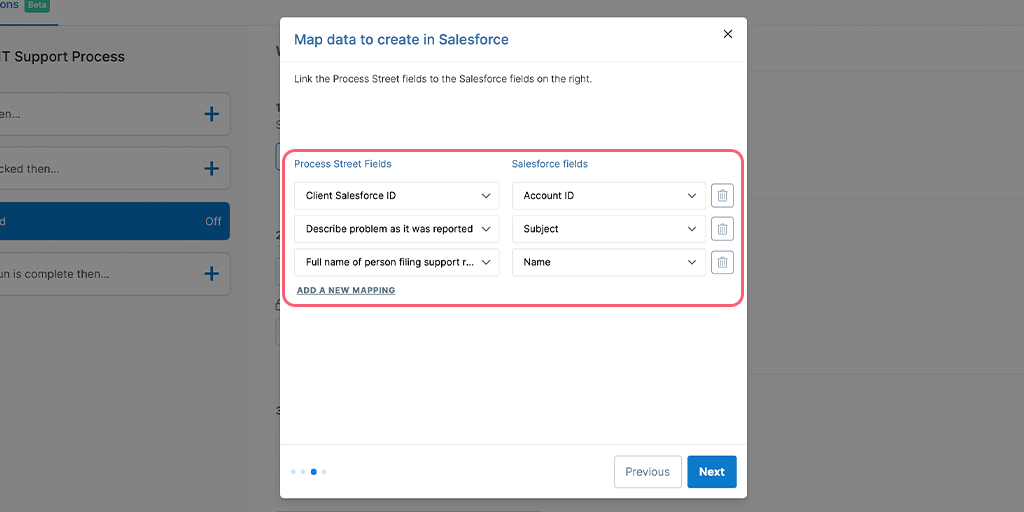
Next, you need to map the fields in Process Street that you would like to create in Salesforce. Eg map “Workflow run name” to the case “Name”.
Click “Add new mapping” to map more fields.

Map data that you’d like to collect in your Process Street workflow run e.g. “Case Number”
Click “Add new mapping” to map more fields and click “Finish” when you’re done mapping.
Now you’re ready to turn on your automation. Use one of the toggle switches shown below, to switch it on.

Now every time you check off that task you create a new case record in Salesforce and also send back data into your Process Street workflow run.
Select “When a workflow run is complete” from the left side of your screen.
Click the Salesforce icon and a small tick will appear to confirm your selection.
Choose one of the following actions, an example for each one follows below:
In this example, when you complete a product demo workflow run with a customer, notes are added to their account record in Salesforce.

When you select your chosen action, a pop-up window will appear and you will be prompted to choose a Salesforce account to run your automation through.
If it’s the first time you are connecting to Salesforce via Process Street, a pop-up window will appear for you to be able to create a new authentication.
Note: You will need to disable pop-ups blockers to allow you to authorize an app.
If you already have an account connected, then you can continue with the one shown, or select another account to add.
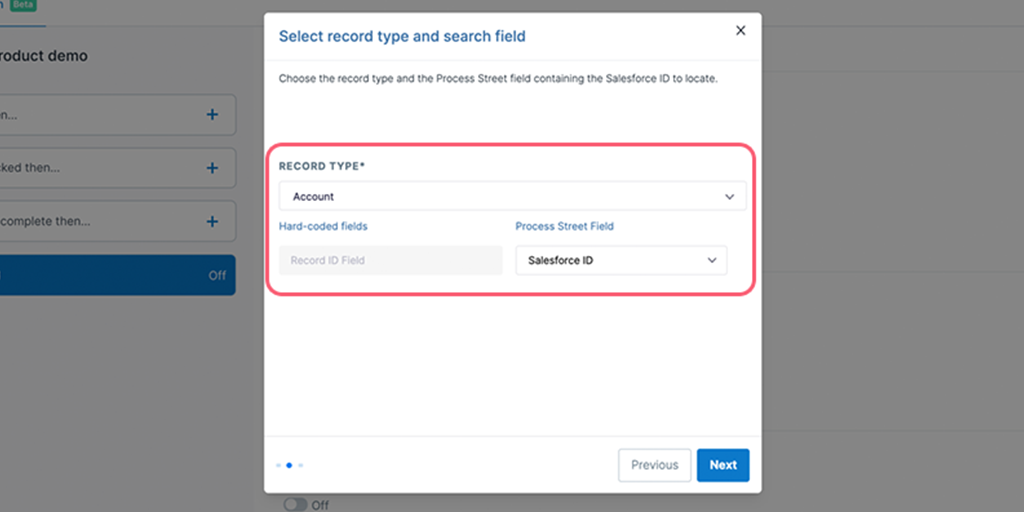
Choose the record type (e.g. Account) and then the Process Street field which contains the Salesforce ID you want to locate.
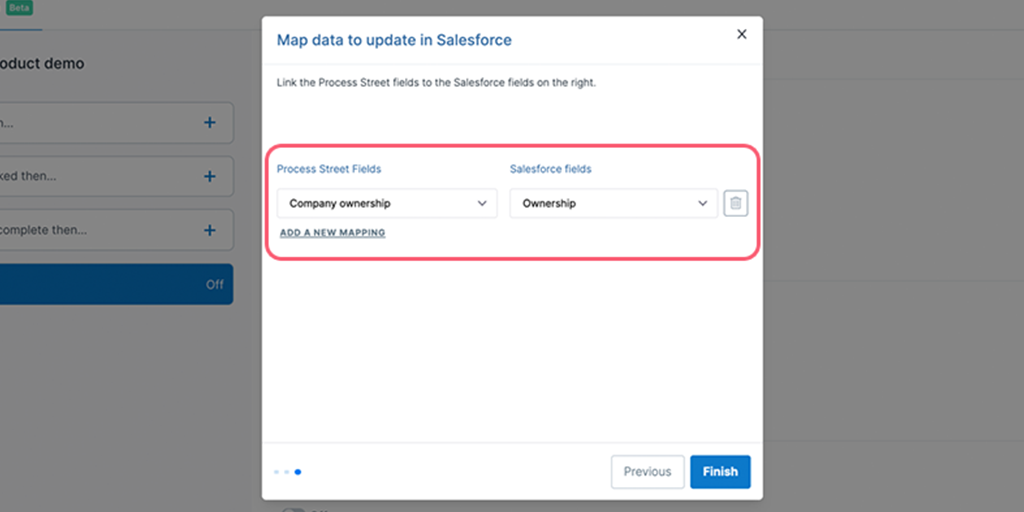
Map data that you’d like to pass into your Salesforce record.
When you’re done, click “Finish”.
Now you’re ready to turn on your automation. Use one of the toggle switches shown below, to switch it on.
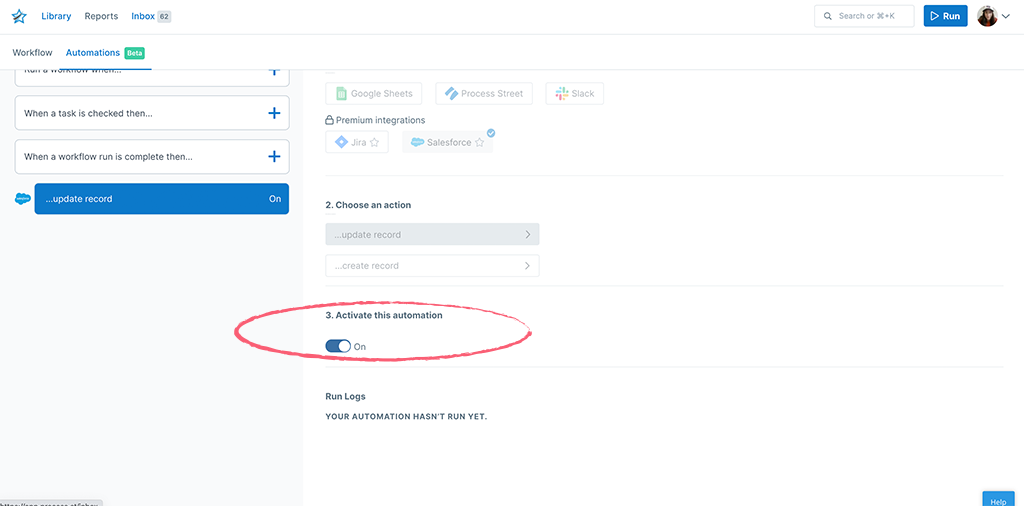
Now every time you complete your workflow run, your account record in Salesforce will be updated with your data mapped accordingly.
In this example, when you complete a client onboarding workflow run, a new task is created in Salesforce, for you to follow up with that customer.
Click the Salesforce icon and a small tick will appear to confirm your selection.
Select “create record”

When you select your chosen action, a pop-up window will appear and you will be prompted to choose a Salesforce account to run your automation through.
If it’s the first time you are connecting to Salesforce via Process Street, a pop-up window will appear for you to be able to create a new authentication.
Note: You will need to disable pop-ups blockers to allow you to authorize an app.
If you already have an account connected, then you can continue with the one shown, or select another account to add.
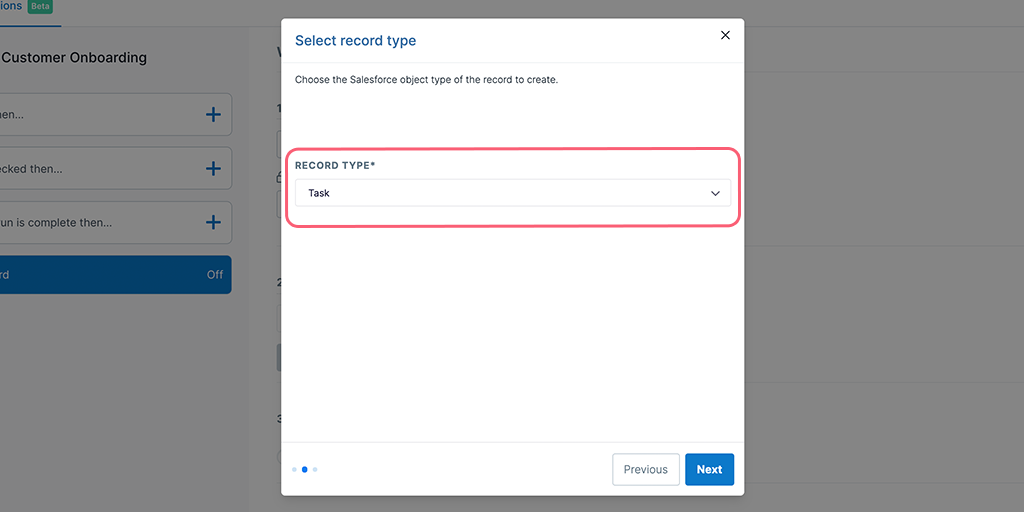
Choose the type of record you would like to create in Salesforce (e.g. “Task”). Click “Next”.
Next, you need to map the fields in Process Street that you would like to create in your new Salesforce record. Eg map “Company name” to “Account name”.
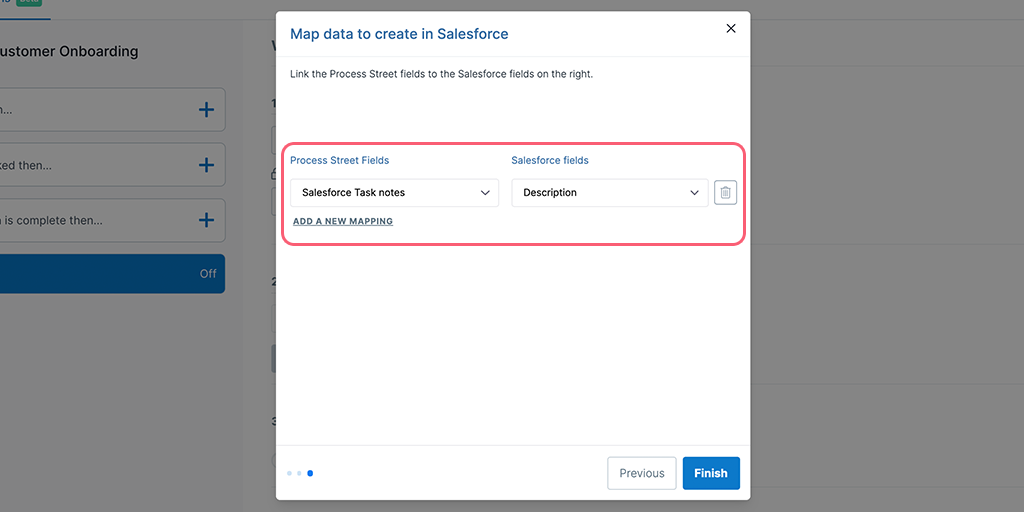
Click “Add new mapping” to map more fields. When you’re done mapping, click “Finish”.
Now you’re ready to turn on your automation. Use one of the toggle switches shown below, to switch it on.
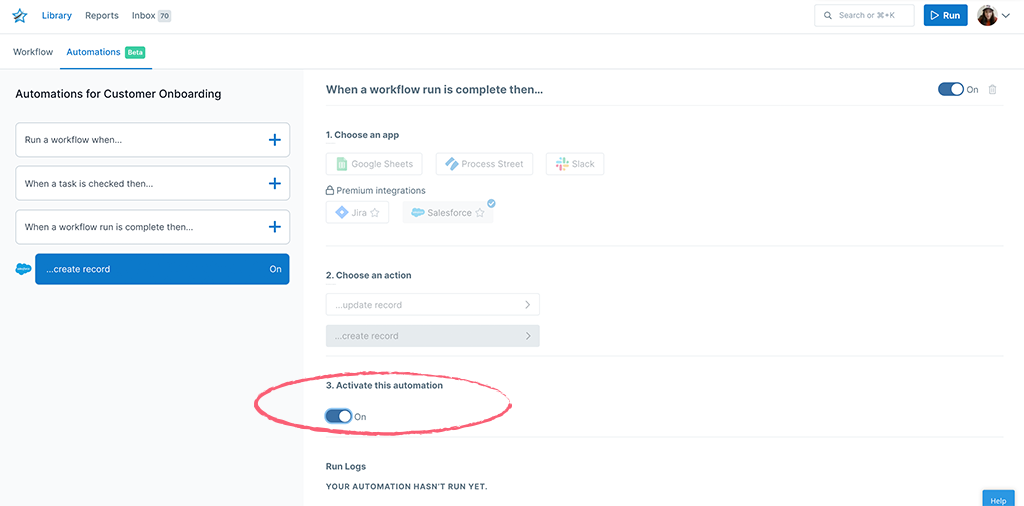
Now every time your workflow run is completed, you will create a new task in Salesforce, with the data you chose to map pulled across into your record.
If you’re looking to create a really robust integration with Salesforce, you can use custom links in your accounts to house a series of Process Street workflow run links.
Your run links pull through variable data into your new workflow runs. Once you have completed all the data fields and notes in your run, you can send the link for your run URL back into the record you started from in Salesforce.
To be able to edit the fields you have mapped in your automation, or change the triggers or actions, you first need to turn off your automation using one of the toggle switches.
To remove an automation from a workflow, you can delete it, but first, you will need to ensure that it has been switched off. Turn the toggle switch to the “off” position and then click the trashcan icon in the top right of your view to delete the automation.
There are no filters, delays, or formulas built into automations. To be able to utilize these types of functions, you might want to consider using formulas and functions in Salesforce or a Zapier integration.
If you would like to request that we add another app to our automations, you can do that from the help button in the bottom right corner of your screen. Click “Suggestions” and send us your request.
If your automation stopped running, isn’t working as expected, or is showing errors, there might be a few reasons for this. Please check the following:
If you find that you are unable to run an automation, this could be to do with your user permissions in Salesforce. Please check with your Salesforce admin to see if you have the correct permission level to allow you to run automations.
You can check your automation run logs to see how your automations are running, or check for errors. You will find the automation run logs in two places, either when viewing a workflow or on workflow runs.
In your workflow on the automations tab, select an existing automation from the left side of your screen (highlighted in blue below). At the bottom of your page, you will see a list of all of the automation runs for that workflow. If your automation hasn’t run yet, you’ll see a message letting you know.

In a workflow run, in the upper right-hand corner of your task list, you’ll see the lightning bolt icon![]() Click the icon to see the run logs for that particular workflow run.
Click the icon to see the run logs for that particular workflow run.
If you have any errors, click the word “Error” to expand more information on why your automation didn’t run.

The lightning bolt icon will only show up on workflow runs that have automations configured on them. This is an automation’s idle state.
When an automation is running, you’ll see the bolt change to the ![]() icon.
icon.
Once the automation finishes running, you’ll see either ![]() for success or
for success or ![]() for failure. If it’s a failure, you can click on the X to see the run logs and then click on the “Error” log for more information.
for failure. If it’s a failure, you can click on the X to see the run logs and then click on the “Error” log for more information.
If you have any questions about using Automations, please reach out to our Process Pros team.